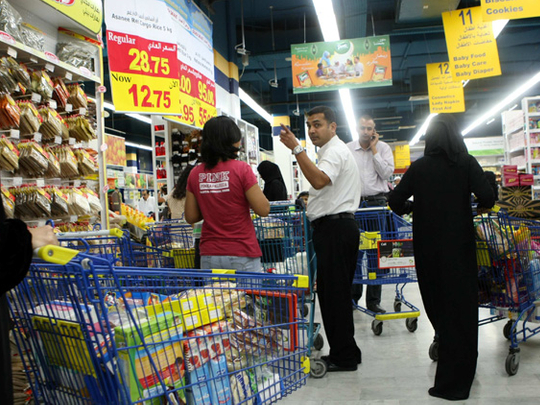
Dubai: The currency peg in the Gulf states will keep the region's economies prone to wild swings in domestic liquidity and inflation as a result of imported interest rates and inflation. Analysts see a long-term solution in speeding up of Gulf currency union and a unified monetary policy independent of US policy.
Speaking on the sideline of the Standard & Poor's Leaders Forum in Abu Dhabi last week, Dr Willem Buiter, Chief Economist of Citigroup, said the macroeconomic management of the Gulf economies will be a difficult proposition in the context of the extremely low US interest rates and the regional currencies pegged to the US dollar.
Gulf countries have been supporting their domestic economies through massive fiscal spending for the past two years. The additional influx of cheap money from quantitative easing in the US is expected to gradually push up inflationary pressures that are beyond the policy tools available here.
Political consensus
"In the Gulf states, the imported interest rates are not suitable to domestic economic conditions. The only alternative is to have a monetary union and common monetary policy independent of the US monetary policy. But it needs political consensus among the Gulf states. Until such times Gulf economies will be prone to wild cyclical fluctuations," said Buiter.
The dollar's slide had caused concern among Gulf oil producers as it pushes down the value of the dollar-denominated oil revenues while the price of their commodity imports, such as grains, have been pushing inflation up.
Emerging markets are already showing signs of overheating because of lower interest rates in the developed world and liquidity moving to these markets. Economists say emerging markets, particularly the Asian and Latin American countries, are expected to witness hyperinflation and asset price bubbles during the next 12 to 18 months, depending on the length of the monetary easing by the US Federal Reserve.
"China is going to see a massive asset price bubble led by property prices followed by equity and fixed income markets. It is difficult to say that the Gulf region will not be impacted by the cross-border capital flows, especially in the absence of active monetary policy tools and a potential jump in oil prices we are likely to see inflation returning to the region," said Prasenjit K. Basu, Managing Director and Chief Economist - Asia of Daiwa Capital Market.
Historic lows
Experts believe, going forward more developed countries are likely to opt for quantitative easing as fiscal policy options have been exhausted in most of these countries while real interest rates are at their historic lows.
"None of the developed nations are in a position to continue with a fiscal boost. Probably the only exception is Germany. Japan and the US are running huge deficits. Thus in case of further demand slowdown in the absence of any scope for a fiscal boost, monetary easing will be the only way forward and that could apply further upward pressure on emerging market currencies and prices and the GCC will be no exception," said Phil Suttle, Deputy Managing Director and Chief Economist of the Institute of International Finance.
Dubai Economists say inflationary pressures arising from the falling dollar and capital inflows are not yet a cause of concern in the Gulf region.
A senior central bank official said last week that the UAE is not worried about the dollar's weakness and is not considering de-pegging the dirham from the dollar "We're not considering de-pegging. At the moment there is no reason for that as more than 50 percent of our trade partners is dollar-related," said Saif Al Shamsi, executive director for the treasury department at the UAE Central Bank.
Even with the current phase of dollar weakness, a return to levels of inflation faced by the region in 2007-08 is unlikely through to the end of 2011. Inflation in Saudi Arabia is now the region's steepest — climbing about 6 per cent in August — but it is resulting more from domestic supply pressures rather than any acute import inflation pressures or depreciation in the real effective exchange rate.
Different forces
"The forces at play today — both domestic and external — are quite different from 2007-08, as Gulf economies are on a recovery path, as is the US economy, hence no harm in following the US policy," said John Sfakianakis, chief economist BSF-Crédit Agricole Group.
According to analysts inflation in the Gulf is neither comforting nor alarming. Qatar experienced deflation of -3.2 per cent in the first three quarters. In the UAE, inflation edged to a 16-month high of 1.2 per cent in September, still way below a record high of 12.3 per cent in 2008.
Economists say Gulf countries are not direct participants in the global currency tensions and there is no urgency to change the dollar peg.
Tight liquidity
"The capital inflows coming into the region will be more than welcome in the context of the tight liquidity in the banking system and a slow pace of credit growth in the region," said Stephen King, group chief economist of HSBC.
Most analysts say at the moment the case for currency revaluation is weak in the region as inflow of capital in the form of bank deposits is not expected to recur as interest rate differentials between the dollar and other emerging market currencies are far higher than between the dollar and Gulf currencies.
Imported price inflation is mainly related to food imports. While food-price inflation is on the rise across the GCC and Mena regions, it is not leading to runaway inflation.
"Inflation is not the main concern for GCC countries at the moment. Qatar is still in deflation, the UAE is experiencing disinflation, and only Saudi Arabia is seeing inflationary pressures," said Marios Maratheftis, Head of Research, Standard Chartered Bank UAE.












